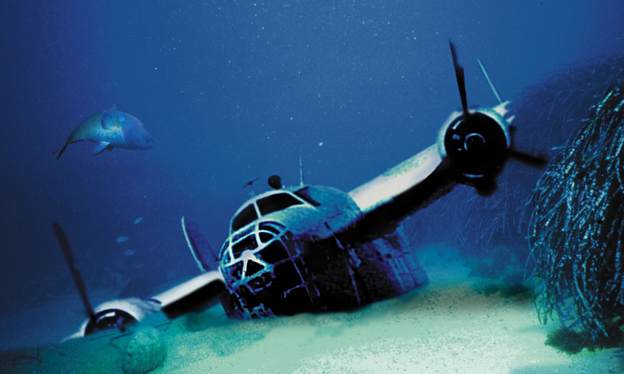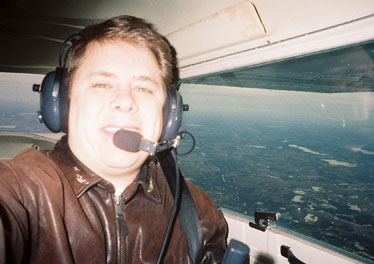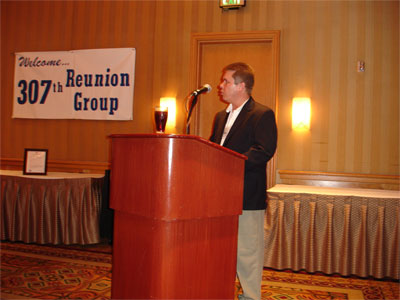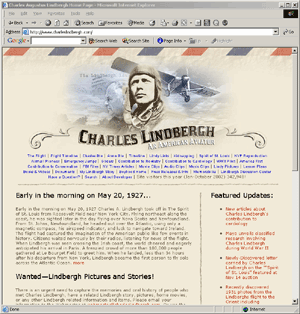
|

March 2006 PacificWrecks.com Interview with Pat Ranfranz: Justin Taylan, the developer/owner of the PacificWrecks.com web site, interviewed Pat Ranfranz regarding his MissingAirCrew.com project. View the PacificWrecks.com interview.

This is how I have always pictured finding the missing Coleman B-24. Although I have not found the plane as of today, I hope to someday have this view! -Pat Ranfranz
. . . Our sons, pride of our nation, have this day set upon a mighty endeavor….They will be sore tired, by night and by day, without rest …. The darkness will be rent by noise and flame. Men's souls will be shaken with the violence of war….Let our hearts be stout, to wait out the long travail, to bear sorrows that may come, to impart our courage unto our sons wheresoever they may be …. These men are lately drawn from the ways of peace…. They yearn for the end of battle, for their return to the haven of home…. Some will never return. Embrace these, Father, and receive them, They heroic servants, into Thy kingdom. —President Franklin Roosevelt, June 1944 Picture Source: http://www.museum.wa.gov.au
|
I started my search for my uncle, T/Sgt John R. McCullough, and his fellow Coleman crew members in 1988 while finishing my History degree at the University of Wisconsin Eau Claire. While growing up I heard stories about my missing uncle who was shot down and never recovered during WWII. My uncle, John, was one of 13 children from a Watertown, South Dakota farm family. In 1942, shortly after Pearl Harbor, the family moved to Covina, California to work at a Goodyear plant to help with the industrial war effort. My mother was 5 years old at the time of the move. John and many of his brothers joined the service or were drafted. John went through Army Air Force radio school and gunnery training in 1943 and shipped out to the Pacific in February 1944 with the 307th Bomb Group. He was lost a few months later. After the loss of my uncle the family received very little information outside of the original telegram that listed him missing in action near Yap Island. I've always had a strong interest in history (college degree) and aviation (private pilot) therefore; the story of my lost uncle fascinated me. I always wondered what happened to John and what would have become of him had he lived. Growing up I replayed the black and white film footage of WWII bombers going down in the movies to imagine what might have happened to my uncle. In 2005 my dream came true. I was able to sit in a dive boat floating off Yap Island and imagine the formation of B-24's coming over the island dropping their bombs as Japanese fighters and AA fire attacked the bomber stream and my uncle's plane plunged into the water just off the southeast reef. I was then able to dive off the boat and scuba down through the crystal clear water to begin the actual search for uncle. I can still remember the chills I received in the warm water on that first dive as I knew I was close to my uncle for the first time. It was only a matter of finding the missing plane.
My thesis on the Development of Air Power
 Patrick Ranfranz meeting with Martin B. Unger (Navigators) sister, Cecile, in New York City on 4 April 2005. As far as I know this was the first meeting between crew family members since the shoot down and crash over 60 years ago. Pat and Cecile enjoyed a wonderful 4 hours sharing information and talking about the families and the crew.
Patrick Ranfranz meeting with Martin B. Unger (Navigators) sister, Cecile, in New York City on 4 April 2005. As far as I know this was the first meeting between crew family members since the shoot down and crash over 60 years ago. Pat and Cecile enjoyed a wonderful 4 hours sharing information and talking about the families and the crew.
|
My thesis research helped me understand the B-24 and the air war in Europe and the Pacific. While writing my thesis that year documents regarding my uncle started to arrive from the military archives. I received the Missing Air Crew report (MACR #10023) in the winter of 1989. For the first time my family had information that listed the other crew members as well as a full account of the shoot down. I shared this information with my uncles and aunts (John's siblings). They in turn helped locate some documents including the original telegram that was sent to my grandparents in July 1944 telling them of John's loss. My mother recalls standing in the doorway listening as the Western Union was delivered and my grandparents read the terrible news that they son was missing in action and likely killed in action over Yap Island in the Pacific.. She remembers their tears as they tried to understand the loss. Although other brothers served during the war, my family was fortunate to have escaped the war with the loss of only one son. My grandfather never forgave the Japanese for the loss of his son. After the war the family returned to their Watertown, South Dakota farm. Like many families who had lost loved ones during the war they endured the victory celebrations and the returning service members with the hope that John had somehow survived the war and would also return as a POW. Sadly as time passed, the family realized John's MIA/KIA status was not going to change. While hundreds of thousands of American WWII causalities were located and returned to the US for burial from 1948-1952, families of the missing in action could only hope to receive more information about their loved ones.
Unrecoverable due to the depth of the water . . .
The military and the US government went to great lengths at a cost of  Click to enlarge.
Click to enlarge.
Patrick Ranfranz meeting with Martin B. Unger (Navigators) widow and sisters in New York City on 12 September 2005. Left to right: Pearl, Leona, Cecile, and Patrick. This was the first meeting between Pearl and the sisters since 1944.
|
billions of dollars to return as many KIA servicemen for burial in the US. The families were given a choice of reburial in US Military cemeteries overseas or the return of the bodies to the US. Each MIA case was reviewed by a military board and the case was closed if the bodies were considered unrecoverable. Unknown to my mother's family, a military board reviewed the Coleman Crew case in 1948 and although they knew the location of the crash site, they determined the crew and plane were unrecoverable due to the depth of the water. The technology of the 1940's did not provide the ability to recover a plane, or bodies, at a depth of 50 feet or 500 feet. Had the plane crashed into shallow waters within the Yap reef the bodies would likely have been recovered after the war, however, only 7 of the 110+ men lost near Yap were ever recovered. The grave recovery teams searched Yap after the war and located 7 sets of remains on the island. Some of the remains were returned to the US for burial yet other men were never located. In one case the grave registration services located multiple marked American graves near the wreckage of a three person Navy TBM-3 Avenger on Yap but only one set of remains were sent home to one family. The other remains were sent to an unmarked grave in the Philippines. In short, the Coleman B-24 (my uncle's plane) and the crew have remained "just off" the southeast reef of Yap Island since the 25 June 1944.
Started the CharlesLindbergh.com web site
December 2006 Update from Pat: I made an agreement with another group to transfer the ownership of CharlesLindbergh.com web site. The new ownership group is planning to rebuild a replica of the Spirit of St. Louis and fly the plane fron New York to Paris in 2008. With the transfer of the CharlesLindbergh.com web site I can now focus my energy on my Missing Air Crew Project.
In the late 90's I found myself reading the Pulitzer Prize winning book titled Lindbergh by A. Scott Berg. At the time I was working as the Director of Web Development for AGS Publishing and decided to use my web development skills to create a web site about Charles Lindbergh. No comprehensive Lindbergh site existed at the time. I started off building pages, adding information, discussion forums, stories, and eventually I found myself dealing with hundreds of thousands of site visitors from around the world. From 2002 on the CharlesLindbergh.com web site has received over 500,000 site visitors each calendar year. I was never sure why I started the CharlesLindbergh.com web site; however, the dots were connected when I received a letter from Dick Beardon, a member of the 307th Bomb Group (same as my uncle). He wrote that Charles Lindbergh was on the same islands during the same time frame as my uncle. The middle-aged Charles Lindbergh traveled to the Pacific as an observer, and eventually ended up flying over 50 combat missions, including one in which he downed a Japanese aircraft. The Roosevelt Administration tried to ban Charles Lindbergh from the military and related industries due to his noninterventionist activities prior to the Japanese attack on Pearl Harbor on Dec. 7, 1941. Lindbergh resigned his commission in the Army Air Corps after Roosevelt publicly denounced him. He tried to reenlist after Pearl Harbor but his request was refused. He then served as a technical adviser and test pilot for the Ford Motor Company and United Aircraft Corporation (now United Technologies Corporation). The Roosevelt Administration would likely have banned Lindbergh from visiting the Pacific had they known ahead of time. Eventually Lindbergh flew over 50 combat missions and shot down a Japanese plane before being asked by the military to return to the US. The letter I received from Mr. Beardon (the member of the 307th bomb group) explained that he and many B-24 crew members owed their lives to Lindbergh because he developed cruise control techniques showing the military how to significantly extend the range of fighter planes during the summer of 1944. Lindbergh's information helped fighters fly farther and stay with the bomber formations thus protecting them from Japanese attacks. Unfortunately, Lindbergh's cruise control techniques came a few days too late for the Coleman crew. Their bomber formation, without the protection of US fighters, was un-escorted to Yap Island and was attacked by 17 Japanese planes. It was just a few months later that bombing formations would have US fighter protection in thanks to Lindbergh's help.
Through this connection I realized my CharlesLindbergh.com web site development and the Coleman crew crossed paths. This realization put me back on the path to discover more about my uncle and the Coleman crew and perhaps find away to bring them home after 60 years.
Received my private pilot license
 Pat Ranfranz flying over northern Minnesota, November 2004
Pat Ranfranz flying over northern Minnesota, November 2004
|
In addition to my web development hobbies I also received my private pilot license and began flying to air shows. One of my biggest thrills was holding short for takeoff a few years ago at the Anoka County Airport in Blaine, Minnesota while a B-24 and B-17 landed a few feet in front of my plane. I spent that weekend at the airport watching the B-24 takeoff and land and could almost picture the throaty roar of the Coleman's Crew's B-24 as it took off from Mokerang Field, Los Negros the morning of June 25, 1944.
My pilot license has allowed me to visit a number of air shows, view American and Japanese aircraft, and meet crew members who served in the Pacific theater. I began locating and reading every book I could find to help me better understand the Coleman crew and their environment in June of 1944. My insatiable appetite for information about the 307th Bomb Group has been both exciting and frustrating. A number of times I have thought I found a breakthrough only to be disappointed with a few holes. For example, I recently located and read a book titled "The Spectator-A World War II Bomber Pilot's Journal of the Artist As Warrior". The author, David Zellmer, served in the 307th Bomb Group at the same time as the Coleman crew. I could not believe my luck. I thought I may have found a resource for more information about the crew and shoot down. Although the book provided a lot of background information about the bases and bomb group, Mr. Zellmer was on rest leave from June 1-30 1944 in Australia and missed the time period of the Coleman Crew shoot down. After finishing the book I located Mr. Zellmer's phone number and tried to call him for more information, however, I was told he had passed away 15 days before I called.
Discovered additional documents  Pat Ranfranz presenting his Missing Air Crew Project at the 307th Bomb Group Reunion in Seattle, WA (August 2006)
Pat Ranfranz presenting his Missing Air Crew Project at the 307th Bomb Group Reunion in Seattle, WA (August 2006)
|
I turned to the Internet and started locating additional sources of information and documents. I connected with the 307th Bomb Group Association and was able to locate a picture of the Coleman crew in one of their reunion books but my family does not recognize my uncle in the picture. This has led me to assume my uncle was not part of the original Coleman crew. I requested and received my uncle's Individual Deceased Personnel file from the archives. Within this file I discovered additional documents such as a 1951 request by the military for my uncle's dental records. This has opened up a series of questions such as;
- Why were the dental records requested years after the case was closed by the review board?
- Did crew members escape of the plane or did bodies wash up on the shores of the island after the crash?
- Did the US find airmen grave sites on Yap in the early 50's?
Sergeant Edward H. Martin
For the first time, I started to consider the possibility that the accounts of the shoot down from the tail gunner on another plane in the formation could have been clouded in the fog of war. After all, all the accounts of the shoot down have been based on the statements of one person, Sergeant Edward H. Martin. He was the last person to see the plane as it crashed into the water. Although I don't doubt Mr. Martin's account of the plane being hit and spinning into the ocean, is it possible he may have missed crew members bailing out during the crash?
Japanese historical accounts
I came in contact with Dr. Pat Scannon with the BentProp.com organization. He was able to locate Japanese historical accounts of the shoot down and additional records that indicate B-24 airmen were captured by the Japanese in the waters off Yap during this time period. Dr. Scannon is continuing to research these accounts at this time. Although my gut feeling still places my uncle and his crew in the plane as it hit the water, I now wonder if this is the end of the story.
 Safely Rest
Safely Rest
From 1945 to 1950, the United States returned 178,000 dead American servicemen back home and reburied another 80,000 in overseas cemeteries at their families' request. Never before had a nation returned so many of its fallen warriors from distant battlefields. But another 78,000 servicemen were still missing in action-their bodies never to be found-their families never to know the peace of closure.
Safely Rest recalls this virtually forgotten episode of WWII through the recollections of the survivors and the letters and histories of the dead themselves. It tells of those who struggled to absorb their loss and rebuild their lives-and of those who would never be able to move on.
|
Honor the memories of the 10 Coleman crew members
In the very least, I want to honor the memories of the 10 Coleman crew members by locating the final details of the shoot down, the crash, and to document their lives up until that fateful day of 25 June 1944. They were only ten of hundreds of thousands who gave their lives during WWII, however, I don't want them to be forgotten in history as memories fade and the loss of their lives becomes buried in history. I'm sure the stories of each crew member's loss in still out there in the memories of each family. Some of this information may now be lost forever with the passage of time. However, I plan to bring the memories of the Coleman crew back from time and provide a perspective on the type of men who give their lives to their countries and then melt into history.
I hope this web site will be my vehicle to locate more information, document the history of the plane and crew members and perhaps close the story. In addition, the technology now exists to locate the Coleman crew and their plane in the Pacific waters "just off" the SE reef of Yap Island. Therefore, I feel it's important to locate the plane and let the families decide if we should bring the men home after 60 years.
Largest obstacle at this time is the cost
The largest obstacle at this time is the cost associated with the equipment necessary to scan the ocean floor and go down to locate and document the crash site. I'm hopeful I can find corporate sponsors and donors who will help me with this part of the project.
Help Needed:
- Locate and explore the crash site with side scanning sonar.
- Use a submersible to document the crash site. (Submersibles provide the means by which we can explore firsthand the ocean depths. Submersibles can now descend to the sea floor to make detailed observations and collect samples)
Technology no longer stands in our way
Visit NOAA at the following link for more information about side scan sonar: http://chartmaker.ncd.noaa.gov/hsd/wrecks.htm
 The Coleman Crew's B-24J (AAF Serial #44-40598) departed Mokerang Field, Los Negros (Bismarck Archipalago) the morning of June 25, 1944 with the ten crew members. After dropping bombs on the airfield of the Japanese held Yap island, the plane was attacked by a Japanese fighter and crashed "just off" the southeast tip of the Yap Island reef.
The Coleman Crew's B-24J (AAF Serial #44-40598) departed Mokerang Field, Los Negros (Bismarck Archipalago) the morning of June 25, 1944 with the ten crew members. After dropping bombs on the airfield of the Japanese held Yap island, the plane was attacked by a Japanese fighter and crashed "just off" the southeast tip of the Yap Island reef.
|
The US military would never allow a modern plane today to sink to the ocean floor without the attempt to recover the crew. Why should we allow the Coleman crew to remain in the water far from home and out of the memories of their families? The decision to list the crew as non-recoverable was made after WWII due to the technology limitations, however, technology no longer stands in our way outside of the cost of gaining access to the technology. The Coleman crew members had no attachments to the Island of Yap outside of the job they were given on the morning of the 25 June 1944. Although I cannot directly speak for the men or their individual families, I'm certain the men could never have imagined spending eternity in the Pacific Ocean in an area they likely never heard of before 1944.
Read an account of a B-24 located near Yap (on Palau) in February 2004
The Coleman crew is considered missing in action and listed on the Tablets of the Missing at Manila American Cemetery in Manila, Philippines.
Returning home . . .
As the men departed Mokerang Field, Los Negros the morning of June 25, 1944 their primary thoughts were likely to return to base later that day and back home to the US once their combat tour had ended. Help me locate the Coleman plane and crew who remain thousands of miles from home.
Contact Pat
Pat Ranfranz can be contacted at: pat@missingaircrew.com
Coleman Crew Memorial on Yap Island
I'm pleased to announce a partnership between the Missing Air Crew Project and the Yap Visitors Bureau (YVB). The two organizations have been working together over the few years to document the history of Yap during World War II. The project goals include creating resources to document and share the history, training the Yap tourism industry on the history, setting up a WWII tour process and to create memorials to remember the life's lost during WWII. The following pictures are of the Coleman Crew memorial that now sits on the shore of the harbor in Colonia, Yap to honor the ten missing crew members including my uncle.
Click on a thumbnail image below to view the full sized image.
Return to top
Submit comments about this site
Web Site Terms of Use: This web site authorizes you to view materials solely for your personal, non-commercial use. You may not sell or modify the material or reproduce, display, distribute, or otherwise use the material in any way for any public or commercial purpose without the written permission of the web site owner. pat@missingaircrew.com
|

|






















 PIN IT
PIN IT